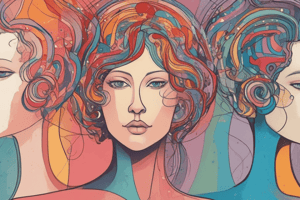Podcast
Questions and Answers
What is the primary difference between formal and informal groups?
What is the primary difference between formal and informal groups?
- Formal groups are more cohesive, while informal groups are less cohesive.
- Formal groups are leaderless, while informal groups have a leader.
- Formal groups are more productive, while informal groups are less productive.
- Formal groups are established by organizations, while informal groups emerge naturally. (correct)
What is the primary goal of problem-solving teams?
What is the primary goal of problem-solving teams?
- To solve complex problems (correct)
- To enhance creativity
- To make decisions
- To increase productivity
Which leadership trait is most closely associated with charisma?
Which leadership trait is most closely associated with charisma?
- Intelligence
- Extraversion
- Conscientiousness
- Personal charm (correct)
According to the Fiedler contingency model, what determines leader effectiveness?
According to the Fiedler contingency model, what determines leader effectiveness?
What is the primary difference between transactional and transformational leadership?
What is the primary difference between transactional and transformational leadership?
What is the primary purpose of using brainstorming and nominal group techniques?
What is the primary purpose of using brainstorming and nominal group techniques?
What is the primary characteristic of trustworthy leaders?
What is the primary characteristic of trustworthy leaders?
What is the primary difference between leadership and power?
What is the primary difference between leadership and power?
What is the main difference between terminal values and instrumental values?
What is the main difference between terminal values and instrumental values?
According to the MBTI framework, what do the four dimensions categorize?
According to the MBTI framework, what do the four dimensions categorize?
What is the main limitation of Maslow's Hierarchy of motivation?
What is the main limitation of Maslow's Hierarchy of motivation?
What are the two main levels of diversity according to the chapter?
What are the two main levels of diversity according to the chapter?
What is the main difference between intellectual ability and physical ability?
What is the main difference between intellectual ability and physical ability?
What is the main purpose of observer ratings in assessing personality?
What is the main purpose of observer ratings in assessing personality?
What is the main relationship between goal-setting theory and self-efficacy theory?
What is the main relationship between goal-setting theory and self-efficacy theory?
What is the main element of expectancy theory?
What is the main element of expectancy theory?
Flashcards are hidden until you start studying
Study Notes
Assessing Personality
- Two common methods of assessing personality are self-report inventories and observer ratings, with observer ratings likely to be more accurate
- The MBTI framework categorizes individuals into 16 personality types based on four dimensions
- My personality type would be INFJ, indicating introversion, intuition, feeling, and judging
- The Big Five personality traits are extraversion, agreeableness, conscientiousness, neuroticism, and openness to experience
- Values are important in OB because they influence behavior, decision-making, and job satisfaction
- Values have two attributes: intensity and centrality
- Terminal values are desired outcomes, while instrumental values are means to achieve those outcomes
Diversity
- The two main levels of diversity are surface-level (demographic) and deep-level (psychological and behavioral)
- Stereotypes can lead to discrimination and misunderstandings in organizations
- Biographical characteristics like age, gender, and education can impact behavior and performance
- Intellectual ability is a person's capacity to process information and solve problems
- Intellectual ability is distinct from physical ability, which refers to manual skills and coordination
- Organizations can effectively manage diversity through training, inclusive policies, and diversity champions
Motivation
- The three key elements of motivation are intensity, direction, and persistence
- Maslow's Hierarchy is an early theory of motivation, still applicable today, but with limitations
- Goal-setting theory and self-efficacy theory are related, as setting challenging goals can enhance self-efficacy
- Expectancy theory states that motivation is based on beliefs about effort, performance, and outcomes
Groups and Teams
- Formal groups are established by organizations, while informal groups emerge naturally
- The punctuated-equilibrium model applies to teams, describing periods of stability and sudden changes
- Group cohesiveness can be increased through shared goals, communication, and social activities
- Status can come from formal positions, expertise, or personal characteristics
- Brainstorming and nominal group techniques are methods for generating ideas, with brainstorming being more free-flowing
- Teams can enhance creativity, productivity, and decision-making
- A group becomes a team when members work interdependently towards a common goal
- Four types of teams are problem-solving, creative, leadership, and virtual teams
- Effective teams have clear goals, good communication, and a supportive climate
- Managers can help individuals become team players by providing training and opportunities for collaboration
Leadership
- Traits of effective leaders include intelligence, extraversion, and conscientiousness
- The Ohio State leadership dimensions are consideration and initiating structure
- Trait theories focus on leader characteristics, while behavioral theories focus on leader actions
- The Fiedler contingency model states that leader effectiveness depends on the match between leader style and situational factors
- Charismatic leadership involves inspiring and motivating others through vision and personal charm
- Transformational leadership focuses on change and innovation, while transactional leadership focuses on task completion
- Trustworthy leaders demonstrate integrity, honesty, and fairness
- Leadership and power are distinct, with leadership focusing on influence and power focusing on authority
- Formal power comes from position, while personal power comes from expertise or relationship
Studying That Suits You
Use AI to generate personalized quizzes and flashcards to suit your learning preferences.



